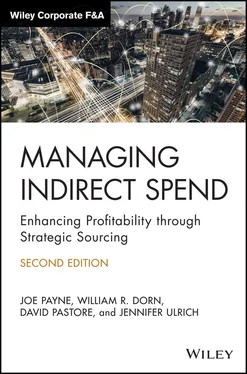Do not let the desire for achieve quick, easy results persuade you to exclude potentially relevant suppliers or technologies. Exploring these options and performing a thorough total cost analysis (including the cost of change) could provide for cost savings opportunities well beyond what could be gained from a unit‐cost perspective alone.
Alternative Processes, Products, and Services
During initial discussions with end users, you may learn that stakeholders are set in their ways. Professionals sometimes develop the mindset that they need to order supplies in a certain way, need specific reports provided on specific days of the week, or need suppliers that are certified (to the end user's satisfaction) in specific processes, software, and quality control methodologies.
Sometimes there are good reasons for these requirements. Many end users have worked hard to discover what they believe to be the best and most efficient processes or best types of suppliers for your organization. It's possible these choices have historically enabled them to prioritize activities that are aligned to their individual goals and objectives while adding more value to the organization. In other cases, these requirements were developed based on what was most familiar to the end user or because the end user did not want to learn something new. In some cases, the requirements were actually developed by the existing supplier, carefully and intentionally implemented under the guise of free training.
What end users often fail to realize is that mandating specific processes or other service requirements onto the supply base without considering alternatives can add costs that exceed any efficiencies they provide. First, stringent service requirements can add to the unit cost of the product or service being purchased. You may not get charged extra for those additional customized reports you receive from your current supplier, but it's possible the supplier factored the cost to produce the reports into the unit cost of the item you are purchasing.
Second, developing specific requirements that only a small number of suppliers can meet limits competition and eliminates alternative processes or enhancements that may be more beneficial to your organization. An example of this might be mandating that your supplier have a certain number of years servicing companies in the same market as your organization. Some end users do this intentionally to limit the number of bidders who can respond to an initiative. This inevitably makes the process easier, but often means missing out.
Another common example of a needless personal requirement is looking for a particular software certification from a supplier as it relates to the company's reporting or transaction management functions in the ERP system. Oftentimes, end users require that any alternate supplier have the same level and type of certification that their current supplier has. Many suppliers can integrate into the major ERP systems or other common software used by most businesses. However, not all suppliers expend the time, energy, and money to go through the process of becoming certified with a particular software publisher. There are many reasons for this; the primary one is that software publishers charge to certify—and these costs can be substantial. Companies go through the certification process to distinguish themselves as partners of a particular software publisher and use that certification in their own marketing, but certification in itself does not always prove that one company is more qualified than another to integrate with a particular system. Ultimately, the only real difference you can confirm (without further research) between a company with a certification and one without is that the certified company paid for the certification.
In this scenario, if you require some level of integration between your systems and those of your supplier, the real requirement is that the supplier is capable of achieving that integration. This might mean it has experience with your particular software or similar software programs. It could even mean that the company partners with a third party that is certified. To achieve proper supplier integration, you need to work with your IT team to determine the types of information being shared, the formats of that information, and all other relevant technical details. Having a certified supplier with demonstrated experience will bolster your confidence that they can deliver on your requirements, but it does not necessarily mean that they can provide the most value to your organization.
When evaluating alternate processes and products, consider what role the current supplier may have played in helping develop the requirement. This is especially true when long‐term suppliers are involved or when it appears that only one or two suppliers can appropriately serve your needs. Suppliers usually have a very detailed knowledge of the marketplace and understand the differences between their offerings and those of their competitors. They often customize requirements for products or services to ensure that no other supplier in the marketplace favorably compares during an apples‐to‐apples assessment. This makes understanding the history of a supplier relationship—and who was involved in developing the initial requirement—all the more important.
Performing a Want‐Versus‐Need Assessment
During the Data Collection phase of your initiative, you determined the current requirement or scope of work. This means you identified the costs associated with a particular spend category and what you expect receive for that money. Hand‐in‐hand with a review of alternative technologies, processes, products, and services, it is worthwhile to determine what the current requirement should be. Many organizations tend to develop a certain level of inertia in their procurement processes—if your organization has purchased a certain item in the past, it tends to use that process well into the future. This is especially true if the reason for the purchase is no longer clear, if multiple end users purchase the same or similar products and services, or if the original purchaser has moved into a new role or has left your organization. Part of the reason for identifying current costs is to determine which of those costs can be factored out entirely.
Corporate banking—particularly corporate cash management (corporate checking accounts)—provides a particularly striking example of the value a want‐versus‐need assessment can provide. If you are familiar with this category, then you know that the statement you get every month could detail hundreds or thousands of charges. Many of these charges come with unclear descriptions that are difficult to understand, such as “CD CK Fine Sort” or “ACH NOCS.”
In one client initiative, the authors of this book assisted a client in sourcing banking and treasury services. After collecting recent invoices, we sat down with representatives of the client's bank and reviewed every charge on their invoices. We asked them to explain any charges that were unclear. In the end, we found that many of the charges were based on services that were no longer required or were redundant. In one case, the client was paying for the same reports to be sent to them electronically, on a CD‐ROM, and faxed—each of these services incurred its own charges! This happened primarily because end users were reluctant to retire the old methods when new technologies became available. This concern drove the decision to continue the duplicate services; however, neither the fax nor the CD‐ROM tools had been used for years. Those services were eliminated as part of the initiative. Doing so produced much more in savings than reducing unit prices for them ever could. As you can see from this example, a want‐versus‐need assessment is an integral part of category research.
Читать дальше












